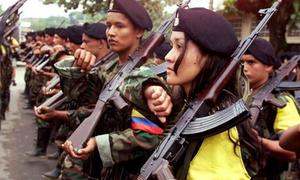The government of Juan Manuel Santos is adjusting its military strategy to concentrate on special operations rather than on sustained large-scale operations such as Plan Patriota, which concentrated in southern Colombia during the early years of the Álvaro Uribe presidency (2002-2010).  Since then, the Revolutionary Armed Forces of Colombia (FARC) as well as the National Liberation Army (ELN) have increasingly adjusted their military strategies and tactics. After suffering serious blows in Cundinamarca, Meta, Caqueta, and Putumayo the FARC, in particular, abandoned its “mobile war,” in which hundreds (and sometimes thousands) of guerrillas carried out large scale offensives against fixed military targets.
Since then, the Revolutionary Armed Forces of Colombia (FARC) as well as the National Liberation Army (ELN) have increasingly adjusted their military strategies and tactics. After suffering serious blows in Cundinamarca, Meta, Caqueta, and Putumayo the FARC, in particular, abandoned its “mobile war,” in which hundreds (and sometimes thousands) of guerrillas carried out large scale offensives against fixed military targets.
The FARC's change in strategies was successful, with victories at El Billar (1998) and Patascoy (2000). Renewed confidence in its military capacity raised its hopes of military victory. But that was prior the direct intervention of the United States and its concerted effort to upend the FARC's progress. In 2000, the United States introduced Plan Colombia, spending $6 Billion over the next ten years to boost the Colombian military, and revamp its structure and armament.
One key result of Plan Colombia was the dramatic increase in the size of the military force, chiefly in professional soldiers. In order to intercept guerrillas and impede their mobility, Plan Colombia created mobile brigades and placed them permanently on strategic mountainous peaks. The Plan was successful in reversing the FARC’s advance and allowed the state to expand its territorial control. But this Colombian military expansion and transformation led the insurgency to also change its military strategy. This chiefly occurred in the case of the FARC, since it was the largest insurgent group and the prime target of Plan Colombia.
These changes created a new dynamic in the conflict. The FARC looked to demonstrate that the government military strategy, and its corresponding military expansion, had reached the point of diminishing returns. This has become clearer over the last year and a half. The FARC increased their military operations in 2011 by 10% from those recorded last year between January and July. These operations were carried out including in the department of Caquetá where Plan Patriota was initiated alongside Nariño, Tolima, Cauca, and Huila. These operations caused the armed forces about 2500 casualties among dead and injured, the highest toll since 2002.
In 2010-11, the FARC carried out operations in 184 out of 1100 Colombian municipalities. That is to say that the FARC, in spite of losing some ground, still retains significant operational capacity in 17% of Colombian municipalities, which translates into roughly 20%-30% of the total national territory.
Given the noted recovery of the FARC and its capacity to adjust to the new conditions of the war, the Santos government is revising its military strategy to adjust to the FARC: concentrating on mobility and special operations rather than on sustained campaigns such as Plan Patriota. This brings the war system dynamics to an “unstable equilibrium” in which neither the state nor the insurgency is capable to win, and each tries to outsmart the other. Meanwhile, the enormous costs of the war exacerbate the country's debt, which amounted to 22.1% of the GDP in 2009 and has since increased. This is not mentioning the human cost of the continuation of the conflict and the long term negative effects on the country’s economic development.

